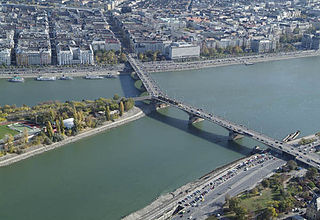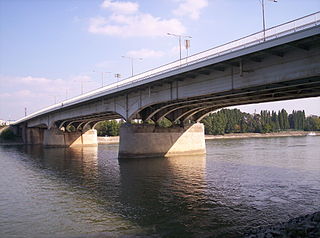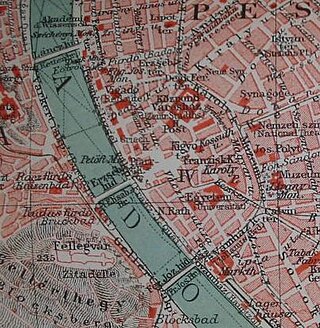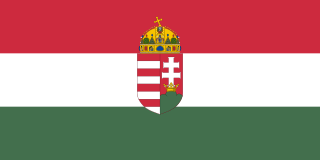
Miklós Horthy de Nagybánya was a Hungarian admiral and statesman who was the regent of the Kingdom of Hungary during the interwar period and most of World War II, from 1 March 1920 to 15 October 1944.

Ferencváros is the 9th district of Budapest, Hungary.

Nagykörút, also Grand Boulevard or Great Boulevard, is one of the most central and busiest parts of Budapest, a major thoroughfare built by 1896, Hungary's Millennium. It forms a semicircle connecting two bridges of the Danube, Margaret Bridge on the north and Petőfi Bridge on the south. Usually the part inside and around this semicircle is counted as the city centre of Budapest.

Kiskörút or Small Boulevard is a major thoroughfare in Budapest. It forms an incomplete semicircle between Deák Square and Fővám Square. It is the border of the southern part of District 5, the innermost district of Pest. As opposed to Nagykörút, it only touches the Danube at its southern end.

Operation Panzerfaust was a military operation undertaken in October 1944 by the German Wehrmacht to ensure the Kingdom of Hungary would remain a German ally in World War II. When German leader Adolf Hitler received word that Hungary's Regent, Admiral Miklós Horthy, was secretly negotiating his country's surrender to the advancing Red Army, he sent commando leader Otto Skorzeny of the Waffen-SS and former special forces commander Adrian von Fölkersam to Hungary. Hitler feared that Hungary's surrender would expose his southern flank, where Romania had just joined with the Soviets and cut off a million German troops still fighting the Soviet advance in the Balkans. The operation was preceded by Operation Margarethe in March 1944, which was the occupation of Hungary by German forces, which Hitler had hoped would secure Hungary's place in the Axis powers. This had also enabled the deportation of the majority of Hungarian Jews, previously beyond the reach of the Nazis, through uneasy cooperation with Hungarian authorities. This policy was, however, terminated as Soviet forces drew closer and the USAAF, based in Italy, began bombing Hungary, including Budapest.

Liberty Bridge or Freedom Bridge in Budapest, Hungary, connects Buda and Pest across the River Danube. It is the third southernmost public road bridge in Budapest, located at the southern end of the City Centre. It was originally named Ferenc József híd (Franz Joseph Bridge).

Elisabeth Bridge is the third newest bridge of Budapest, Hungary, connecting Buda and Pest across the River Danube. The bridge is situated at the narrowest part of the Danube in the Budapest area, spanning only 290 m. It is named after Elisabeth of Bavaria, a popular queen and empress of Austria-Hungary, who was assassinated in 1898. Today, her large bronze statue sits by the bridge's Buda side connection in the middle of a small garden.

Margaret Bridge or Margit híd is a three-way bridge in Budapest, Hungary, connecting Buda and Pest across the Danube and linking Margaret Island to the banks. It is the second-northernmost and second-oldest public bridge in Budapest.

Árpád Bridge or Árpád híd is a bridge in Budapest, Hungary, connecting northern Buda (Óbuda) and Pest across the Danube.

Rákóczi Bridge is a bridge in Budapest, Hungary, connecting the settlements of Buda and Pest across the Danube. The construction of the steel girder bridge was started in 1992 to the plans of Tibor Sigrai.

The Hotel Gellért is a historic Art Nouveau hotel established in 1918 and located on the west bank of the Danube in Budapest, Hungary.

Kossuth Memorial refers to one of three public monuments dedicated to former Hungarian Regent-President Lajos Kossuth in front of the Hungarian Parliament Building on Lajos Kossuth Square in Budapest. The memorial is an important Hungarian national symbol and scene of official celebrations.

Móricz Zsigmond körtér is a square in Budapest, Hungary.
The bridges of Budapest, Hungary, crossing the River Danube from north to south are as follows:

The Megyeri Bridge, previously known as the Northern M0 Danube bridge, is a cable-stayed bridge that spans the River Danube between Buda and Pest, respectively the west and east sides of Budapest, the capital of Hungary. It is an important section of the M0 ringroad around Budapest.

The Danube Promenade is located on the Pest side of Budapest, Hungary. The promenade itself lies on the left bank of the Danube, extending from the Széchenyi Chain Bridge to the Erzsébet Bridge.

The Kingdom of Hungary, referred to retrospectively as the Regency and the Horthy era, existed as a country from 1920 to 1946 under the rule of Miklós Horthy, Regent of Hungary, who officially represented the Hungarian monarchy. In reality there was no king, and attempts by King Charles IV to return to the throne shortly before his death were prevented by Horthy.

The Government of National Unity was a Nazi-backed puppet government of Hungary, which ruled the German-occupied Kingdom of Hungary during World War II in Eastern Europe. After the joint coup d’état with which the Nazis and the Arrow Cross Party overthrew the government of the Regent of Hungary, Miklós Horthy, the Arrow Cross Party established the coalition Government of National Unity on 16 October 1944.

The city of Budapest was officially created on 17 November 1873 from a merger of the three neighboring cities of Pest, Buda and Óbuda. Smaller towns on the outskirts of the original city were amalgamated into Greater Budapest in 1950. The origins of Budapest can be traced to Celts who occupied the plains of Hungary in the 4th century BC. The area was later conquered by the Roman Empire, which established the fortress and town of Aquincum on the site of today's Budapest around AD 100. The Romans were expelled in the 5th century by the Huns, who were challenged by various tribes during the next several centuries. The Hungarian conquest of the Carpathian Basin started at the end of the 9th century, and the Kingdom of Hungary was established at the end of the 11th century.

















